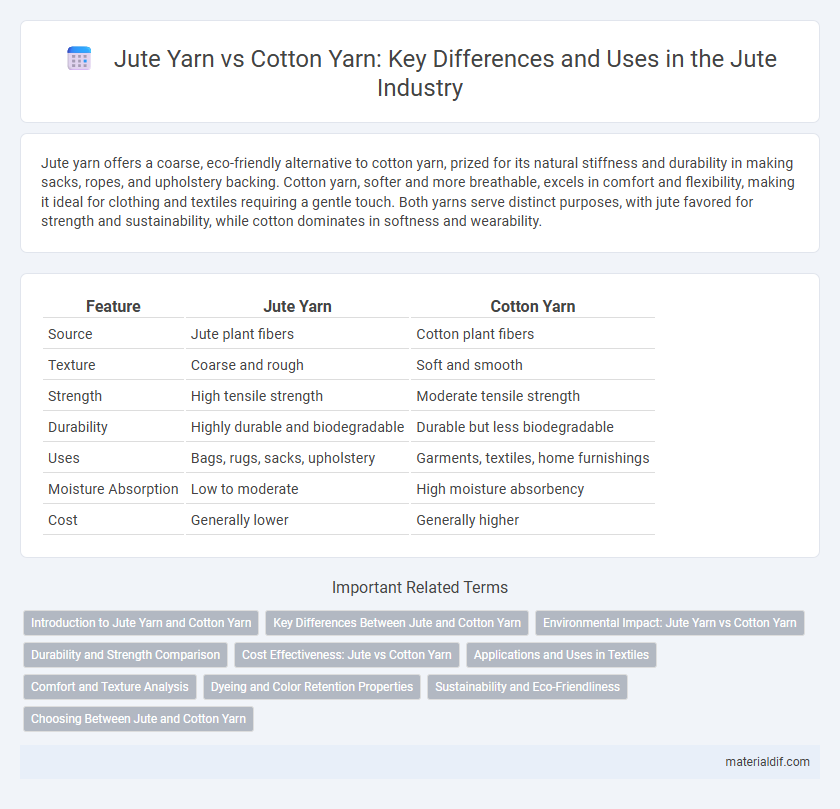Jute yarn offers a coarse, eco-friendly alternative to cotton yarn, prized for its natural stiffness and durability in making sacks, ropes, and upholstery backing. Cotton yarn, softer and more breathable, excels in comfort and flexibility, making it ideal for clothing and textiles requiring a gentle touch. Both yarns serve distinct purposes, with jute favored for strength and sustainability, while cotton dominates in softness and wearability.
Table of Comparison
| Feature | Jute Yarn | Cotton Yarn |
|---|---|---|
| Source | Jute plant fibers | Cotton plant fibers |
| Texture | Coarse and rough | Soft and smooth |
| Strength | High tensile strength | Moderate tensile strength |
| Durability | Highly durable and biodegradable | Durable but less biodegradable |
| Uses | Bags, rugs, sacks, upholstery | Garments, textiles, home furnishings |
| Moisture Absorption | Low to moderate | High moisture absorbency |
| Cost | Generally lower | Generally higher |
Introduction to Jute Yarn and Cotton Yarn
Jute yarn, derived from the natural fibers of the jute plant, is known for its strength, coarseness, and eco-friendly properties, making it ideal for packaging and home decor products. Cotton yarn, obtained from cotton fibers, is prized for its softness, breathability, and versatility, commonly used in apparel and textiles. Both yarns serve distinct purposes, with jute offering durability and sustainability, while cotton provides comfort and flexibility.
Key Differences Between Jute and Cotton Yarn
Jute yarn is coarser, stronger, and more sustainable compared to soft, breathable cotton yarn, making it ideal for packaging and upholstery versus apparel and intimate wear. Unlike cotton yarn, jute fibers are naturally golden brown and biodegradable, contributing to eco-friendly textile production with minimal chemical processing. Cotton yarn offers superior moisture absorption and elasticity, while jute provides durability and resistance to wear, influencing their specific industrial applications.
Environmental Impact: Jute Yarn vs Cotton Yarn
Jute yarn has a significantly lower environmental impact compared to cotton yarn due to its biodegradable nature and minimal need for pesticides or synthetic fertilizers during cultivation. Cotton farming requires extensive water resources and chemical use, leading to soil degradation and water pollution. Jute cultivation, being rain-fed and eco-friendly, contributes to sustainable agriculture with a smaller carbon footprint.
Durability and Strength Comparison
Jute yarn exhibits superior strength and durability compared to cotton yarn, making it ideal for heavy-duty applications such as sacks and upholstery. The natural coarseness and fibrous structure of jute contribute to its high tensile strength and resistance to wear and tear. In contrast, cotton yarn is softer but less durable, often requiring blending for enhanced longevity in textiles.
Cost Effectiveness: Jute vs Cotton Yarn
Jute yarn offers a more cost-effective solution compared to cotton yarn due to its lower production expenses and higher yield per hectare. While cotton requires significant water and pesticides, increasing overall costs, jute thrives with minimal inputs, reducing cultivation expenses. This makes jute yarn an economically favorable option for industries seeking sustainable and budget-friendly fiber alternatives.
Applications and Uses in Textiles
Jute yarn is primarily used for making burlap, sacks, rugs, and eco-friendly bags due to its coarse texture and high durability, making it ideal for industrial and agricultural textiles. Cotton yarn, known for its softness and breathability, is extensively used in garment manufacturing, bedding, and fine textiles requiring comfort and flexibility. While jute yarn excels in packaging and home decor applications, cotton yarn dominates in apparel and high-quality textile products.
Comfort and Texture Analysis
Jute yarn offers a coarse texture and lower elasticity, making it less soft compared to cotton yarn, which is renowned for its smoothness and breathable comfort. Unlike cotton yarn, jute's rough fibers can cause irritation when in direct contact with skin, limiting its use in apparel meant for prolonged wear. Cotton's moisture-wicking property and finer fibers ensure superior softness and comfort, ideal for textiles demanding close skin contact.
Dyeing and Color Retention Properties
Jute yarn exhibits lower dye affinity compared to cotton yarn due to its coarse, lignin-rich fibers, resulting in less vibrant and shorter-lasting colors after dyeing. Cotton yarn, composed of cellulose fibers, absorbs dyes more effectively, ensuring brighter hues and superior color retention even after multiple washes. The natural moisture absorbency of cotton enhances dye fixation, whereas jute's limited absorption leads to faster fading and less washfastness.
Sustainability and Eco-Friendliness
Jute yarn is highly sustainable due to its biodegradable nature and low water consumption during cultivation, making it an eco-friendly alternative to cotton yarn. Cotton farming requires substantial amounts of water, pesticides, and synthetic fertilizers, leading to significant environmental degradation. The renewable and fast-growing characteristics of jute contribute to its superior eco-friendliness compared to cotton yarn.
Choosing Between Jute and Cotton Yarn
Jute yarn offers superior strength, durability, and eco-friendliness compared to cotton yarn, making it ideal for sustainable textile production and packaging materials. Cotton yarn provides softness, breathability, and moisture absorption, which are essential qualities for apparel and bedding applications. Selecting between jute and cotton yarn depends on the specific requirements of the end product, balancing factors such as texture, strength, and environmental impact.
Jute Yarn vs Cotton Yarn Infographic

 materialdif.com
materialdif.com